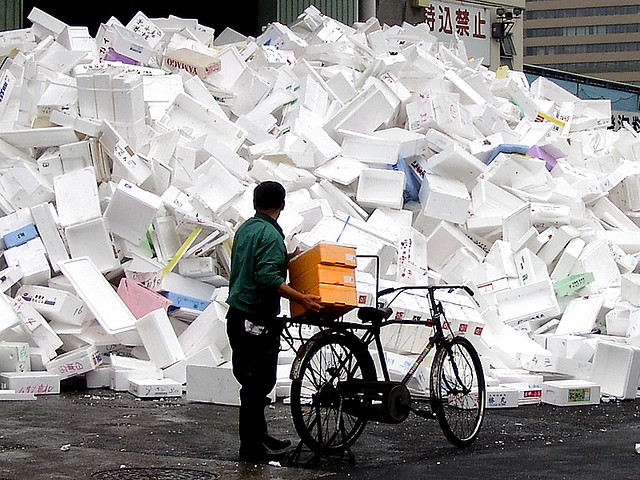
It’s finally warm and cookout season is upon us. After a tough winter, I’m sure everyone will be taking every opportunity to soak up the sun and enjoy the warmth!
In honor of the warm weather, you may be stocking up on all your disposable plates, tables cloths, utensils. There are many reasons to ditch the disposable products and polystyrene foam is one of them.
Why avoid polystyrene foam?
Polystyrene foam contains the chemical styrene, which has been linked to cancer, vision and hearing loss, impaired memory and concentration, and nervous system effects…the list goes on. What happens when you ingest hot liquids and possibly hot food from polystyrene foam cups and plates is that the styrene may leach out of the foam food service ware and into our bodies.
Styrene is such a problematic chemical, it’s included on the Hazardous 100+ list that we’re encouraging retailers to move away from.
Like many chemicals, we know about their health effects from worker exposures. Effects of chronic styrene exposure that many manufacturing workers face include depression, headaches, fatigue, and weakness, and minor effects on kidney function. The US Department of Labor, Occupational Safety & Health Administration and the EPA are aware of styrene’s negative effects but have yet to successfully limit its usage. This is one of many reasons we need policy reform of OSHA and TSCA to protect our American workforce.
- Styrene: A toxic chemical used to make polystyrene resins and other materials. CD Cases, food-service products, and luggage; you name it, this chemical might be there.
- Polystyrene: Created from styrene, polystyrene is a stiff and transparent synthetic resin that can be combined with other materials to add rigidity to them or foamed by itself and made into insulation, packaging materials, and food-service ware.
- Polystyrene foam: By this term, we mean “expanded polystyrene” (EPS). It is made from polystyrene and is used for many things like surfboards, bean bags, and of course as disposable plates and cups.
Environmental impacts
In 1986, the EPA released a report that listed the polystyrene manufacturing process as the fifth largest source of hazardous waste.
As if the public health impact of polystyrene isn’t enough, its environmental effects are well documented. It may take 500 years to decompose and fills up an estimated 25-30% of the space in our world’s landfills, if it even ends up there. In addition, our lakes, waterways and oceans are suffering thanks to polystyrene waste.

Where is styrene found?
Styrene isn’t only found in styrofoam products.
Plastic, rubber, carpets, and even packing peanuts all may have traces of styrene. So our chances of exposure come from a variety of sources.
Are there alternatives?
We always like to recommend that people opt for reusable plates, cups, and utensils before purchasing disposables. This cuts back on waste and reduces your exposure to toxic chemicals.
What you can do
Styrene is very difficult to recycle, so many are opting to avoid the product altogether. Many schools and cities are banning Styrofoam products, and many retailers are beginning to offer alternatives.
You can avoid polystyrene cups and containers, which are usually labeled with the number 6 inside the chasing arrows. When you’re getting food to-go, ask if they have non-Styrofoam options and encourage the restaurant to switch to reusable to-go containers. Also, when shopping for groceries, select items that are unwrapped.




